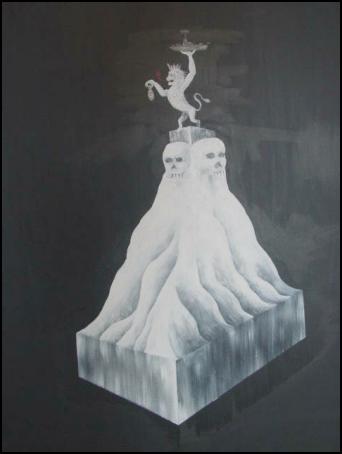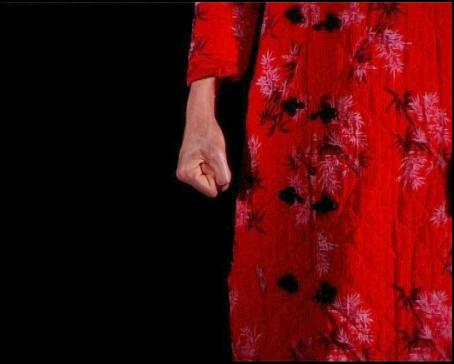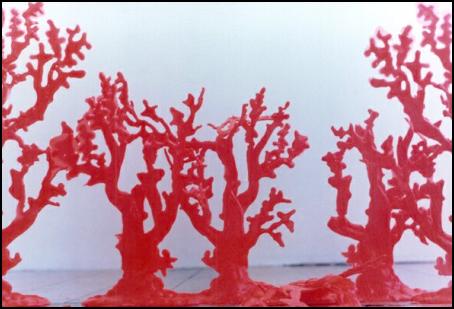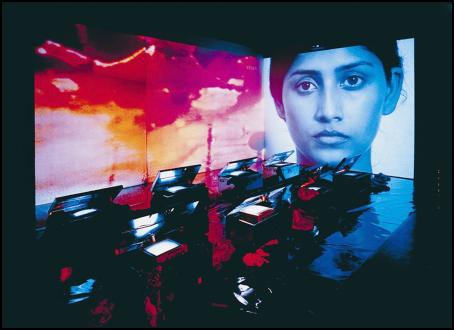Power And Propaganda At The Adam Art Gallery
Power And Propaganda At The Adam Art Gallery
BOMBS AWAY (5 July – 15 August 2003)
While the war on ‘terror’ is played out on the international stage, a current exhibition – Bombs Away – at Victoria University's Adam Art Gallery explores the meaning and impact of nuclear weaponry.

Tony de Lautour
Monument 2002
acrylic on canvas
Bombs Away features the work of six leading New Zealand artists, including new works by Tony de Lautour and Jo Randerson, and additional works unseen in New Zealand by Austrian-born, New York-based artist, Rainer Ganahl. Concurrently, the gallery presents: Remembering Toba Tek Singh by internationally acclaimed Indian artist Nalini Malani.
In what promises to be a topical and provocative presentation, the New Zealand component of Bombs Away responds to government films of atomic testing in an exhibition presented 16 years after legislation was passed making New Zealand a nuclear-free nation.
In Bombs Away, visual artists Richard Reddaway, Fiona Jack and Tony de Lautour, dancer Megan Adams with Paul Redican, and writer Jo Randerson, each explore the pro-nuclear argument from the perspective of one of the five original nuclear nations (United States, Russia, China, France and Britain).
Exhibition curator Sophie Jerram says by using the official government atomic testing films as a starting point, the artists take on the role of nuclear propagandist in order to reveal more about New Zealand's position as a nuclear free country.
The government films include one from the US, Testing Nuclear Weapons, at Nevada, and emphasises safety and security controls, without recourse to the wider implications of the work scientists were doing.

Megan Adams with Paul Redican
Little Red Dance (Fist) (detail) 2002
digital video still
"Fiona Jack's smoky artworks made in response to this film refer not only to radioactive clouds but also to the gases of propaganda that threaten to seep into our minds and muddy our thoughts. She was three-years-old when the United States film was made and her work recalls her childhood fears of nuclear attacks."
Dancer Megan Adams, in collaboration with Paul Redican, has created a video capturing the refined, celebratory aspects of the Chinese army's highly practised military exercises (as shown in Mao's Little Red Video of 1966) by creating a fictitious comrade who doubles as a cultural performer (dancer Liana Yew). Digitally cloned, this contemporary comrade dances as an army of tightly choreographed soldiers in a countdown sequence.

Richard Reddaway
No-one Believes They are Evil 2002
wax
In another work, sculptor Richard Reddaway's luminous, brittle wax growths resemble the coral of Moruroa Atoll, and are pliable but unstable, unable to hold their form after exposure to extreme climatic changes. His work is a response to France's 1995 film of nuclear testing at Moruroa Atoll.
In his works, Ganahl, Austria’s representative to the Venice Biennale in 1999, uses texts and images from news broadcasts and print media as a starting point, to examine the role of the media in the understanding and framing of international conflicts.
Remembering Toba Tek Singh, first shown as part of the Asia-Pacific Triennial in 2002 at the Queensland Art Gallery, deals with the ongoing implications of the 1947 separation of India and Pakistan, and is a reaction to nuclear testing in both countries.
In Remembering Toba Tek Singh the iconic clouds of nuclear detonations at Hiroshima and Nagasaki are juxtaposed by the large-scale images of two women from India and Pakistan attempting to fold a sari – an act that is doomed to failure on account of the unbridgeable physical space that separates them. Images encompassing the cycles of life, birth and death are seen alongside drawings which Malani has animated as a filmic montage of figures that melt and reform – a provocative reminder of the physical consequences of nuclear radiation.

Nalini Malani
Remembering Toba Tek Singh 1998-99
video installation
Purchased 2000. Queensland Art Gallery Foundation Grant
Queensland Art Gallery Collection
Photograph: Richard Stringer
The work is based on a short story by Sadat Hasan Manto that tells of the exchange of Indian hospital patients transported from one country to another when India was divided. According to the story, the patients themselves were unable to distinguish whether they were in India or Pakistan. The story follows a man called Bishan Singh from the village of Toba Tek Singh. During the changeover, Singh became so confused as to the precise location of his native village that he stood on the border between India and Pakistan and fell down.
KAINGA TAHI KAINGA RUA (5 July – 15 August 2003)
Kainga Tahi Kainga Rua brings together, in collaboration, the artistic direction and work of Brett Graham and the research of Dr Katerina Teaiwa. A major multi-media installation, the exhibition centres on Banaba, a small island in the Republic of Kiribati, and explores the issue of phosphate mining undertaken by the Australian and New Zealand governments from 1900 to 1979.
For developing farming industries within New Zealand and Australia, phosphate fertiliser was highly sought after as a commodity, and over 20 million tonnes of phosphate was shipped from Banaba, destroying 437 hectares of the 607-hectare island. As a consequence of the mining the indigenous people of the island, the Banabans, were removed to Rabi Island in Fiji in 1945.
Kainga Tahi Kainga Rua reveals the history of Banaba and its people, and raises questions about the role New Zealand played in the fate of the island and the country’s place in the Pacific.
Brett Graham is a leading New Zealand sculptor having worked on many public commissions, including work for the old Broadcasting House site in Wellington and more recently for the North Shore Court House. In 1996, at the Bartley Nees Gallery in Wellington, he created an exhibition, Bravo Bikini to commemorate the 50th Anniversary of the nuclear weapon testing programme at Bikini Atoll. Katerina Teaiwa is Assistant Professor, Center for Pacific Islands Studies, University of Hawai'i.
Bombs Away with Rainer Ganahl is presented by the Physics Room and The Stealth Foundation while Remembering Toba Tek Singh is presented in association with Queensland Art Gallery with the support of the Asia 2000 Foundation of New Zealand and Sony. Kainga Tahi Kainga Rua is presented at the Adam Art Gallery with support from The University of Auckland.
Adam Art Gallery, Victoria University, Tuesdays - Sundays 11am - 5pm. Closed Mondays and Public Holidays.
Contact Kate Griffin, Exhibitions and Public Programmes Officer, 04 463 5229, for further information, images or to arrange interviews.
EXHIBITION
OPENING
Friday 4 July Join exhibiting
artists, curators and gallery staff for the
Opening
5.30pm of Bombs Away, Remembering Toba Tek
Singh and Kainga Tahi
Kainga Rua.
Opening Speakers:
Terence O’Brien – former New Zealand Ambassador to the United Nations, founding Director for the New Zealand Centre for Strategic Studies at Victoria University and lecturer and writer on international affairs.
Garry Nicholas – General Manager, Toi Maori Aotearoa – Maori Arts New Zealand.
FLOORTALKS
Saturday 5 July
Exhibiting artist, Brett Graham and Dr. Katerina Teaiwa,
consider
11am Kainga Tahi Kainga Rua as a
critical examination of phosphate
mining on the island
of Banaba. Looking at both the creative development of this
major audio-visual installation and the research
underpinning it, the event will consider how the ‘death’ of
Banaba resulted in the ‘growth’ of New Zealand.
Thursday 10 July Bombs Away curator Sophie
Jerram is joined by renowned New
6.15pm Zealand
researcher and writer, Nicky Hager, for a discussion of
the Bombs Away exhibition, focusing on
individual works – and the
topical issues raised by them
– by New Zealand artists and international contributor
Rainer Ganahl.
Saturday 2 August Dr. Julie Roberts
(Senior Lecturer, Massey University School of
11am
Fine Arts) and Dr. Pushpa Wood (Research Manager, Massey
University, Wellington and New Zealand President, World
Conference on Religion and Peace) discuss
Remembering Toba Tek Singh – examining the work in the
context of both time-based media practice and its
significant cultural and socio-political content.
FORUM
PROCESSING POWER AND PROPAGANDA: whose role is it to
inform in the public interest?
Saturday 19 July
A critical discussion examining how messages about power
and
11am conflict are framed and understood,
taking the Bombs Away
exhibition as a starting
point:
with panelists:
Brett
Graham
Artist and Lecturer, Elam School of Fine Arts,
University of Auckland
Rod Prosser
Documentary
film-maker
Richard Reddaway
Exhibiting artist and
Lecturer, Department of Art and Design Studies, Massey
University, Wellington
Alastair Thompson
Editor, Scoop Online News (www.scoop.co.nz)
Chair
Sophie Jerram
Exhibition curator and
writer
Exploring the meaning and impact of nuclear weaponry from diverse perspectives and in wide ranging genres, the Adam Art Gallery presents an informal film series. Chairs will be provided – but feel free to bring a cushion! Admission by gold coin. Tea and coffee provided.
Thursday 7 August Quiet Earth (NZ, 1985,
91mins, Director: Geoff Murphy)
5.30pm A
post-apocalyptic 1980s New Zealand sci-fi film by acclaimed
director Geoff Murphy that centres on scientist Zac
Hobson – Bruno
Lawrence – waking to find he is alone in
the world, or so it seems,
due to a top secret power
plant accident that has wiped out the
population.
Sunday 10 August Atomic Café (US, 1982, 88 mins,
Director: Kevin Rafferty, Jayne
5.30pm Loader,
Pierce Rafferty)
Compiling archival film clips,
presented in pseudo-documentary style,
Atomic Café is a
cult classic focusing on the development of nuclear weapons
in the United States. Characterised by a chilling black
humour, Atomic Café is at once both a clever and poignant
look at a significant period in the development of the
world’s dominant nuclear power.
Thursday 14 August
PACIFIC 3,2,1, ZERO (NZ, 1993, 20 mins, Director: Gregor
Nicholas)
5.30pm & When the Wind Blows (UK, 1988,
85mins, Director: Jimmy Murakami)
PACIFIC 3210
is major film collaboration, documenting a provocative
anti-nuclear protest work by the internationally
acclaimed New Zealand performance group From Scratch. Using
large custom built instruments made from industrial plastics
and extruded metal to create a variety of strictly
non-electronic sounds in a mesmerizing performance – which
is part sculpture, part music and part ritual – with Phil
Dadson, Wayne Laird & James McCarthy.
When the Wind
Blows
A deeply moving animation of Raymond Brigg’s
comic book about an elderly couple’s preparation for the
outbreak of nuclear war. Convinced that the coming conflict
will provide a sense of community and togetherness that they
recall from World War II, the reality of nuclear disaster is
in stark contrast with their romanticised memories.
ENDS


 GPNZ: Extended Skill Mix In Primary Care Teams Improves Patient Access And Outcomes
GPNZ: Extended Skill Mix In Primary Care Teams Improves Patient Access And Outcomes New Zealand Symphony Orchestra: Music Legend To Conduct Bach, Beethoven And Mozart With NZSO
New Zealand Symphony Orchestra: Music Legend To Conduct Bach, Beethoven And Mozart With NZSO Ministry of Health: Ministry Of Health To Look Further At Waikato Hospital Event
Ministry of Health: Ministry Of Health To Look Further At Waikato Hospital Event Emirates Team NZ: Statement From Emirates Team NZ On Auckland Hosting Of 38th America’s Cup
Emirates Team NZ: Statement From Emirates Team NZ On Auckland Hosting Of 38th America’s Cup PPTA Te Wehengarua: Draft English Curriculum Lacks Connection With Reality
PPTA Te Wehengarua: Draft English Curriculum Lacks Connection With Reality Oratia Books: Revised Edition Of Much-praised History Examines The Great War Experience Of New Zealand, Australia And Canada
Oratia Books: Revised Edition Of Much-praised History Examines The Great War Experience Of New Zealand, Australia And Canada